Wikipedia:Picture of the day/October 2006
|
Featured picture tools: |
These featured pictures, as scheduled below, appeared as the picture of the day (POTD) on the English Wikipedia's Main Page in October 2006.
You can add an automatically updating POTD template to your user page using {{Pic of the day}} (version with blurb) or {{POTD}} (version without blurb). For instructions on how to make custom POTD layouts, see Wikipedia:Picture of the day.
October 1 - Sun
[edit]
|
A male dance fly (Empis livida), of the family Empididae, a family of flies with over 3,000 described species. Empidids are mainly predatory flies and exhibit a wide range of forms but are generally small to medium sized, non-metallic and rather bristly. Distribution is worldwide but the majority are found in northern temperate areas. Photo credit: André Karwath |
Text version ( view - edit - talk - history ) — Condensed version ( view - edit )
Column version ( view - edit ) — Row version ( view - edit )
October 2 - Mon
[edit]
|
Wikipe-tan, a moé anthropomorphization of Wikipedia, similar in theme to an OS-tan. In Japanese animation, "moé" characters are those designed to elicit a protective or loving response from the audience. Moé anthropomorphism is a form of anthropomorphism where moé qualities are given to non-human beings, objects, concepts, or phenomena. Like many moé characters, Wikipe-tan is designed to be a cute young girl, and this image shows her in a maid costume, decorated with puzzle pieces. Image credit: Kasuga |
Text version ( view - edit - talk - history ) — Condensed version ( view - edit )
Column version ( view - edit ) — Row version ( view - edit )
October 3 - Tue
[edit]
| |||||||
This map shows the tracks of all tropical cyclones which formed worldwide from 1985 to 2005. The points show the locations of the storms at six-hourly intervals and use the color scheme shown on the right from the Saffir-Simpson Hurricane Scale.
Diagram credit: Nilfanion | |||||||
Text version ( view - edit - talk - history ) — Condensed version ( view - edit )
Column version ( view - edit ) — Row version ( view - edit )
October 4 - Wed
[edit]
|
| Hacha Grande (562m), in the south of the Canary Island of Lanzarote, viewed from the road to the Monumento Natural de los Ajaches (Punta de Papagayo). Lanzarote is a volcanic island with very low rainfall; much of the south of the island is desert and a barren expanse of lava flows.
Photo credit: Yummifruitbat |
Text version ( view - edit - talk - history ) — Condensed version ( view - edit )
Column version ( view - edit ) — Row version ( view - edit )
October 5 - Thu
[edit]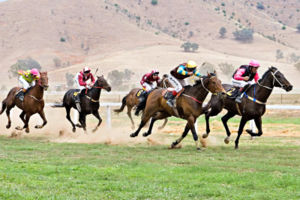
|
Horses race on grass at the 2006 Tambo Valley Races in Swifts Creek, Victoria, Australia. Horseracing is the third most popular spectator sport in Australia, behind Australian rules football and rugby league, with almost 2 million admissions to the 379 racecourses throughout Australia in 2002–03. Photo credit: Fir0002 |
Text version ( view - edit - talk - history ) — Condensed version ( view - edit )
Column version ( view - edit ) — Row version ( view - edit )
October 6 - Fri
[edit]
|
Sixth century mural from the wall of the Ajanta Caves, Maharashtra, India, painted during the Gupta Empire. These paintings, like many produced in this time period, freely depict nudity, romantic themes or sexual situations, reflecting the lack of taboos against sex in a society that also produced the Kama Sutra and the Tantric school of Indian philosophy. Photo credit: The Yorck Project |
Text version ( view - edit - talk - history ) — Condensed version ( view - edit )
Column version ( view - edit ) — Row version ( view - edit )
October 7 - Sat
[edit]|
A sculler rowing in front of the European Parliament building in Strasbourg, France. Although Brussels is usually considered the 'capital' of the European Union, the Parliament meets monthly in Strasbourg. The rival demands of Belgium and France to base parliament in their state has prevented a final agreement as to which city would become the sole seat of parliament. Photo credit: Andreas Tille | |
Text version ( view - edit - talk - history ) — Condensed version ( view - edit )
Column version ( view - edit ) — Row version ( view - edit )
October 8 - Sun
[edit]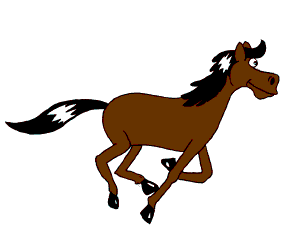
|
An animated cartoon of a galloping horse. This animation was created by rotoscoping Eadweard Muybridge's pioneering 19th century photos. The animation consists of 8 drawings, which are "looped", i.e. repeated over and over. Image credit: J-E Nyström |
Text version ( view - edit - talk - history ) — Condensed version ( view - edit )
Column version ( view - edit ) — Row version ( view - edit )
October 9 - Mon
[edit]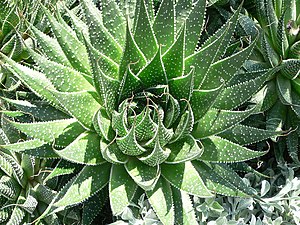
|
Aloe aristata, also known as Torch Plant and Lace Aloe, is a species of aloe indigenous to South Africa and surrounding countries. It is a stemless, and saw-toothed succulent plant. Its nectar-rich flowers tend to attract birds and bees easily. Photo credit: Raul654 |
Text version ( view - edit - talk - history ) — Condensed version ( view - edit )
Column version ( view - edit ) — Row version ( view - edit )
October 10 - Tue
[edit]
|
Three willow flowers appearing as catkins. Willows are deciduous trees and shrubs in the genus Salix, part of the willow family Salicaceae. Willows are dioecious with male and female catkins on different plants; the catkins are produced early in the spring, often before the leaves or as the new leaves open. Photo credit: André Karwath |
Text version ( view - edit - talk - history ) — Condensed version ( view - edit )
Column version ( view - edit ) — Row version ( view - edit )
October 11 - Wed
[edit]
|
An HDR image of Tower Bridge at twilight crossing the Sacramento River in Sacramento, California. Completed in 1935, this was the first vertical lift bridge in the California Highway System. It is 52 feet (15.8 m) wide, 737 feet (223.3 m) long, and 160 feet (48.5 m) tall. There are four lanes for cars, and one large center lane for a railroad. Photo credit: Phreakdigital/Fir0002 |
Text version ( view - edit - talk - history ) — Condensed version ( view - edit )
Column version ( view - edit ) — Row version ( view - edit )
October 12 - Thu
[edit]
|
The Amur Tiger (Panthera tigris altaica), also known as the Siberian, Korean, Manchurian, or North China Tiger, is a critically endangered subspecies of tiger (P. tigris). About 500 individuals are left in the wild, mostly in the regions of Primorye and Khabarovsk of eastern Russia. Photo credit: S. Taheri/Fir0002 |
Text version ( view - edit - talk - history ) — Condensed version ( view - edit )
Column version ( view - edit ) — Row version ( view - edit )
October 13 - Fri
[edit]
|
The central electrode of a plasma lamp, showing a glowing blue plasma streaming upwards. The colors are a result of the radiative recombination of electrons and ions and the relaxation of electrons in excited states back to lower energy states. These processes emit light in a spectrum characteristic of the gas being excited. Photo credit: Blaise Frazier |
Text version ( view - edit - talk - history ) — Condensed version ( view - edit )
Column version ( view - edit ) — Row version ( view - edit )
October 14 - Sat
[edit]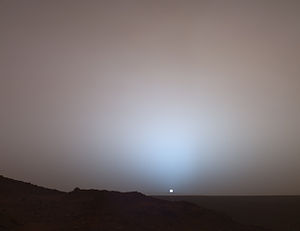
|
Photograph of a Martian sunset taken by the Spirit rover at Gusev crater, May 19 2005. Spirit is the first of the two Mars Exploration Rover missions. She successfully landed on Mars at 04:35 Ground UTC on January 4 2004 and has operated successfully for over one full Martian year or two Earth years. Her twin Opportunity landed successfully on Mars on January 24 2004. Photo credit: NASA |
Text version ( view - edit - talk - history ) — Condensed version ( view - edit )
Column version ( view - edit ) — Row version ( view - edit )
October 15 - Sun
[edit]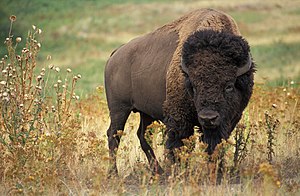
|
The American Bison (Bison bison), is a bovine mammal that is the largest terrestrial mammal in North America, and one of the largest wild cattle in the world. With their huge bulk, bison are only surpassed in size by the massive Asian gaur and wild water buffalo, both of which are found mainly in India. Photo credit: Jack Dykinga, USDA |
Text version ( view - edit - talk - history ) — Condensed version ( view - edit )
Column version ( view - edit ) — Row version ( view - edit )
October 16 - Mon
[edit]
|
This animation shows the changing views of spacetime along the world line (the dashed line) of a rapidly accelerating observer under the special theory of relativity, proposed by Albert Einstein in 1905. The vertical direction indicates time and the horizontal direction indicates distance, and the dots on the world line are spaced at regular proper time intervals. The diagonal lines show the particle's light cone at that time. The other dots are random events. Animation credit: Cyp |
Text version ( view - edit - talk - history ) — Condensed version ( view - edit )
Column version ( view - edit ) — Row version ( view - edit )
October 17 - Tue
[edit]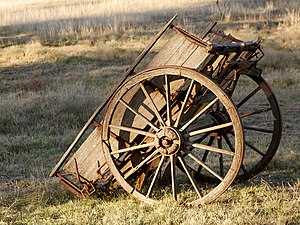
|
Carts have many different shapes but the basic idea of transporting material (or maintaining a collection of materials in a portable fashion) remains. Carts usually have two or four wheels. Those with four wheels (also known as drays or wagons) will often have a pivoting front axle that has a pole connected to the collars or yoke of the two guiding draught animals. Photo credit: Fir0002 |
Text version ( view - edit - talk - history ) — Condensed version ( view - edit )
Column version ( view - edit ) — Row version ( view - edit )
October 18 - Wed
[edit]
|
A domesticated Swan Goose (Anser cygnoides) with a "knob" (found in some variations) above its beak. This knob is more prominent on males than on females and can be used for sexing by 6–8 weeks of age. Wild Swan Geese can be found in Mongolia and eastern Russia. They are migratory and winter mostly in south and east China. Photo credit: Alan D. Wilson |
Text version ( view - edit - talk - history ) — Condensed version ( view - edit )
Column version ( view - edit ) — Row version ( view - edit )
October 19 - Thu
[edit]
|
Havasu Falls, one of the four waterfalls of the Havasupai Indian Reservation, is located near the village of Supai, Arizona. It is the second of four falls on Havasu Creek, which empties into the Grand Canyon on the Colorado River. The water of Havasu Creek has a bluish green tint due to the heavy lime content of the water. The fall is forked and looks like two falls when the river is flowing heavily. Photo credit: Moondigger |
Text version ( view - edit - talk - history ) — Condensed version ( view - edit )
Column version ( view - edit ) — Row version ( view - edit )
October 20 - Fri
[edit]
|
Pangong Tso is a lake in the Himalayas situated at a height of about 4500 m (14850 ft). It is 134 km long and extends from India to Tibet. Two thirds of the length of this lake falls in the People's Republic of China. It is only 8 km wide at its broadest point. In winter, the lake freezes completely despite being salt water. Photo credit: Martin Louis |
Text version ( view - edit - talk - history ) — Condensed version ( view - edit )
Column version ( view - edit ) — Row version ( view - edit )
October 21 - Sat
[edit]
|
Apa Tani tribal women, with traditional tattoos and bamboo nose ornaments in Hija village, Ziro, Arunachal Pradesh, India. Originally, this practice started because the women wanted to look unattractive to males from other tribes. Apa Tani women were considered to be the most beautiful among all the Arunachal tribes. Photo credit: doniv |
Text version ( view - edit - talk - history ) — Condensed version ( view - edit )
Column version ( view - edit ) — Row version ( view - edit )
October 22 - Sun
[edit]
|
Portrait of American photographer Dorothea Lange atop a Ford Model B car in 1936. Lange is best known for her Depression-era work for the Farm Security Administration. Lange's photographs, such as Migrant Mother, humanized the tragic consequences of the Great Depression and profoundly influenced the development of documentary photography. Photo credit: Paul Schuster Taylor/Moondigger |
Text version ( view - edit - talk - history ) — Condensed version ( view - edit )
Column version ( view - edit ) — Row version ( view - edit )
October 23 - Mon
[edit]
|
In this example of isometric projection, the blue sphere is two levels above the red one, but this can't be seen locally. If the pier that the blue sphere is on were extended by one square, it would align perfectly with the square the red sphere is on, creating an optical illusion. Some of the famous "impossible architecture" works of M.C. Escher exploit this isometric limitation. Illustration credit: Algr/Icey |
Text version ( view - edit - talk - history ) — Condensed version ( view - edit )
Column version ( view - edit ) — Row version ( view - edit )
October 24 - Tue
[edit]
|
A wakizashi, a traditional Japanese sword, on display at the Tokyo National Museum. The wakizashi is the smaller cousin of the katana and together the two swords were worn as a matched pair, or daisho, by samurai warriors. Towards the end of the Edo period, samurai swords became elaborate status symbols, with lavish decoration on the hilt and scabbard displaying the owner's wealth. Photo credit: Chris 73 |
Text version ( view - edit - talk - history ) — Condensed version ( view - edit )
Column version ( view - edit ) — Row version ( view - edit )
October 25 - Wed
[edit]
|
A wide-angle view of Horseshoe Bend, a horseshoe-shaped meander in the Colorado River, from State Route 89. It is located approximately 4 miles (6.4 km) south of Page, Arizona, slightly downstream from the Glen Canyon Dam and Lake Powell. Photo credit: Moondigger |
Text version ( view - edit - talk - history ) — Condensed version ( view - edit )
Column version ( view - edit ) — Row version ( view - edit )
October 26 - Thu
[edit]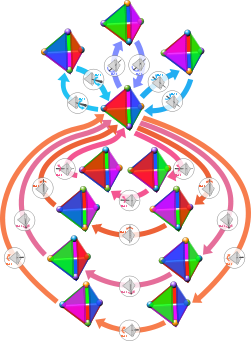
|
Symmetry is a foundational concept in several sub-disciplines of mathematics, particularly geometry and abstract algebra. The rotation symmetry group of the tetrahedron (shown here) associates the 12 different orientations of a tetrahedron with two kinds of spatial rotation that rearrange those orientations: a 120° rotation around each of the 4 vertices (reddish arrows), and 180° rotation through opposite edges (blue arrows). Diagrams illustrating the symmetries of a mathematical object in this format are called cycle graphs. Illustration credit: Debivort |
Text version ( view - edit - talk - history ) — Condensed version ( view - edit )
Column version ( view - edit ) — Row version ( view - edit )
October 27 - Fri
[edit]
|
Flowers of the cultivar Hebe × franciscana, commonly known as "Blue Gem" or "Veronica", a member of the Hebe genus. This hybrid has been known to be continuously in flower for stretches over two years. Hebes are grown in many gardens and public areas as they attract butterflies. They cope with most soil types, and can be propagated easily from both seed and cuttings. Photo credit: Fir0002 |
Text version ( view - edit - talk - history ) — Condensed version ( view - edit )
Column version ( view - edit ) — Row version ( view - edit )
October 28 - Sat
[edit]
|
Composite photo of the Sun and Earth, showing the difference in size between the two astronomical objects. Although the Sun is an average-sized star, it is so large that its volume is equivalent to 1.3 million Earths and it contains approximately 99% of the total mass of the Solar System. Image credit: Brian0918, from NASA photos |
Text version ( view - edit - talk - history ) — Condensed version ( view - edit )
Column version ( view - edit ) — Row version ( view - edit )
October 29 - Sun
[edit]
|
Animation of a drop of water falling from a tap. While still connected to the tap, surface tension counters the gravitational pull until the drop becomes too large and heavy to be supported. This animation is made of 18 separate images, not all of the same water drop, but different pictures of different drops arranged to make them look like a series of pictures of one drop. Image credit: Chris 73/Gmaxwell |
Text version ( view - edit - talk - history ) — Condensed version ( view - edit )
Column version ( view - edit ) — Row version ( view - edit )
October 30 - Mon
[edit]
|
A Canada Goose in flight. This well-known species is native to North America. It breeds in Canada and the northern USA in a variety of habitats. Like most geese, it is naturally migratory, the wintering range being most of the USA. Photo credit: Alan D. Wilson/Diliff |
Text version ( view - edit - talk - history ) — Condensed version ( view - edit )
Column version ( view - edit ) — Row version ( view - edit )
October 31 - Tue
[edit]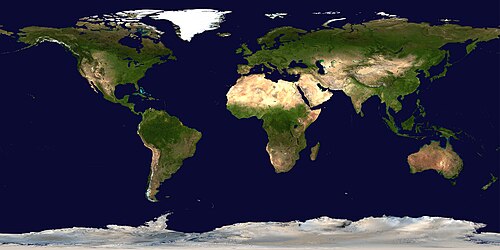
|
| Composite satellite image of the whole world in a plate carrée projection, a very simple map projection that has been in use since the earliest days of spherical cartography. The name is from the French for "flat and square". It is a special case of the equidistant cylindrical projection in which the horizontal coordinate is the longitude and the vertical coordinate is the latitude.
Photo credit: NASA |
Text version ( view - edit - talk - history ) — Condensed version ( view - edit )
Column version ( view - edit ) — Row version ( view - edit )
Picture of the day archives and future dates
